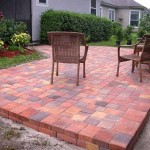Cost of Natural Stone Patio Per Sq Ft 2024: A Comprehensive Guide
Constructing a natural stone patio represents a significant investment, offering both aesthetic appeal and long-term durability. Understanding the various factors influencing the cost per square foot is crucial for homeowners planning such a project in 2024. This article provides a detailed breakdown of these factors, offering insights into material costs, labor expenses, site preparation, and other considerations that contribute to the overall expense.
The cost of a natural stone patio can vary widely depending on the type of stone selected. Options range from relatively inexpensive flagstone and tumbled pavers to more premium choices like granite and bluestone. Geographical location also plays a considerable role, as material availability and transportation costs fluctuate across different regions. Labor rates, which are influenced by local market conditions and the complexity of the project, contribute significantly to the overall cost.
Beyond material and labor, several other factors impact the final price. Site preparation, including excavation, grading, and the installation of a proper base, is essential for a stable and long-lasting patio. Permitting fees, drainage considerations, and the inclusion of additional features like steps or retaining walls can further increase the total expenditure. This article will dissect these elements in detail, offering a clear picture of the costs associated with building a natural stone patio in the current market.
Breaking Down Material Costs
The selection of natural stone dramatically affects the overall cost per square foot. Flagstone, a sedimentary rock characterized by its natural cleft and irregular shapes, is often one of the more affordable options. Its price typically ranges from $2 to $6 per square foot, depending on the thickness, color, and availability. Flagstone is commonly used for creating rustic and informal patios.
Pavers, which are pre-cut and often tumbled for a more consistent appearance, offer a wider range of materials, including travertine, limestone, and sandstone. The cost for natural stone pavers can range from $5 to $15 per square foot, depending on the stone type and finish. Travertine, known for its porous texture and light colors, is a popular choice for its elegant and durable qualities. Limestone, another sedimentary rock, offers a more muted palette and a smoother surface. Sandstone provides a variety of colors and textures, offering versatile design options.
More premium options like granite and bluestone represent a higher investment. Granite, an igneous rock known for its exceptional durability and resistance to staining, typically ranges from $10 to $25 per square foot. Its dense composition and inherent strength make it suitable for high-traffic areas. Bluestone, a type of sandstone characterized by its distinctive blue-gray hues, also falls in the $10 to $25 per square foot range. Bluestone is prized for its elegant appearance and slip-resistant surface.
The thickness of the stone is also a crucial factor influencing the cost. Thicker stones generally require less underlying support and are more durable, but they are also more expensive. For patios designed for heavy use or vehicular traffic, thicker stones are recommended, while thinner stones may suffice for pedestrian areas. The choice of stone thickness should be carefully considered in relation to the intended use of the patio and the overall budget.
Transportation costs for the selected stone must also be factored into the overall material expenses. Natural stone is heavy and bulky, and transporting it from the quarry or supplier to the construction site can represent a significant expense, particularly for projects located far from sources of supply. Sourcing stone locally can help to mitigate these transportation costs.
Labor Expenses and Installation Factors
Labor costs represent a substantial portion of the total cost of a natural stone patio. Installation involves several stages, including site preparation, base construction, stone laying, and joint filling. Experienced installers are essential for ensuring a structurally sound and aesthetically pleasing patio.
Labor rates for installing natural stone patios typically range from $5 to $15 per square foot, depending on the complexity of the project and the prevailing wage rates in the area. Projects involving intricate patterns, curves, or steps will generally command higher labor costs. The experience and skill of the installers also influence the price, with more experienced professionals often charging higher rates.
The complexity of the installation is directly related to the shape and size of the stone. Irregularly shaped stones, such as flagstone, require more cutting and fitting, increasing the labor time. Pavers, with their uniform shapes and sizes, are generally easier and faster to install, resulting in lower labor costs. The chosen laying pattern also influences labor time, with more complex patterns requiring greater precision and attention to detail.
Site conditions can also impact labor expenses. Uneven or sloped sites may require more extensive excavation and grading, adding to the labor time. Obstacles such as trees, utility lines, or existing structures may also complicate the installation process and increase labor costs. Access to the site is another consideration, as limited access can slow down the delivery of materials and increase the time required for installation.
The choice of jointing material can also affect labor costs. Polymeric sand, which is a popular choice for filling the joints between stones, requires careful application and compaction to prevent cracking and weed growth. Mortar, another option for joint filling, is more time-consuming to apply and requires skilled craftsmanship for a durable and aesthetically pleasing finish.
Site Preparation, Permitting, and Additional Costs
Proper site preparation is fundamental to the longevity and stability of a natural stone patio. This process typically involves excavation, grading, and the installation of a compacted base. Excavation removes topsoil and organic matter, creating a level surface for the patio. Grading ensures proper drainage and prevents water from pooling on the patio surface.
The base, typically composed of compacted gravel or crushed stone, provides a stable foundation for the stone surface. The depth of the base depends on the soil conditions and the intended use of the patio. In areas with poor drainage or heavy clay soils, a deeper base may be required to prevent settling and frost heave. The cost of site preparation can range from $1 to $5 per square foot, depending on the extent of the excavation and the materials used for the base.
Permitting requirements vary depending on local regulations. In some areas, a permit may be required for any patio construction, while in others, permits may only be necessary for patios exceeding a certain size or located within a specific setback from property lines. Permitting fees can range from a few hundred dollars to several thousand dollars, depending on the jurisdiction and the complexity of the project. It is essential to check with local building departments to determine the specific permitting requirements in your area.
Drainage considerations are crucial for preventing water damage and ensuring the longevity of the patio. Proper drainage can be achieved through grading, the installation of drainage pipes, or the construction of a French drain. The cost of drainage improvements can range from $500 to several thousand dollars, depending on the complexity of the system.
Additional features, such as steps, retaining walls, or built-in seating, can further enhance the functionality and aesthetic appeal of a natural stone patio, but they also add to the overall cost. Steps can be constructed from natural stone or pre-cast concrete and typically cost between $100 and $500 per step. Retaining walls can be constructed from natural stone, brick, or concrete blocks and can cost between $20 and $50 per square foot. Built-in seating can be constructed from natural stone or wood and can cost between $500 and $2000 per linear foot.
Landscaping around the patio can also add to the overall cost. Planting trees, shrubs, and flowers can enhance the aesthetic appeal of the patio and provide shade and privacy. The cost of landscaping can vary widely depending on the type and quantity of plants selected.
Finally, consider the cost of ongoing maintenance. Natural stone patios require periodic cleaning and sealing to protect them from staining and weathering. The frequency of maintenance depends on the type of stone and the environmental conditions. Regular cleaning with a mild detergent and water is typically sufficient for most natural stone patios. Sealing can help to prevent staining and water damage and should be done every few years.

2025 Patio Cost To Build And Install Angi

How Much Does A Stone Patio Cost 2025 S

How Much Does A Paver Patio Cost To Install 2025 Data Angi

How Much Does A Patio Cost 2025 S

How Much Does A Paver Patio Cost To Install 2025 Data Angi

How Much Does A Stone Patio Cost To Install

Paver Patio Cost More Affordable Than You Might Think Elevate Outdoor

How Much Does A Stone Patio Cost 2025 S

How Much Does A Paver Patio Cost

2025 Paver Patio Cost Installation Costs
See Also








